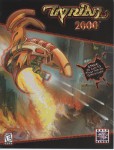$20 errr…. Free Game of the Week: Tyrian (PC, iPhone, and Pretty Much any Other Platform The Open Source Version Has Been Ported To)
by William Talley, filed in $20 Game Of The Week, Games on Jan.07, 2011
 Before Unreal, Gears of War, and Bulletsotrm (and after Jazz Jackrabbit, ZZT, and Jill of the Jungle) Epic Megagames released this vertical scrolling shooter. While it contains classic shooter action in the vein of Raiden and Xevious, it contains a few tricks of its own that make it unique. The game was originally conceived as a tech demo by two friends Alexander Brandon and Jason Emery. It didn’t even have sound, although it was shopped out to both Epic and Apogee Software. Epic eventually considered the game a perfect fit for thier company, and hooked the team up with sound composers and graphic designers, and thus Tyrian was born. You play as Trent, a terraformation expert. After being sent to the planet Tyrian to do some terraforming work, your friend is assassinated by Microsol (not Microsoft), the corporation controlling the terraforming effort due to his knowledge of a rare mineral being mined on the planet. Realizing that you’re next on Microsol’s hit-list, you set out to make your escape.
Before Unreal, Gears of War, and Bulletsotrm (and after Jazz Jackrabbit, ZZT, and Jill of the Jungle) Epic Megagames released this vertical scrolling shooter. While it contains classic shooter action in the vein of Raiden and Xevious, it contains a few tricks of its own that make it unique. The game was originally conceived as a tech demo by two friends Alexander Brandon and Jason Emery. It didn’t even have sound, although it was shopped out to both Epic and Apogee Software. Epic eventually considered the game a perfect fit for thier company, and hooked the team up with sound composers and graphic designers, and thus Tyrian was born. You play as Trent, a terraformation expert. After being sent to the planet Tyrian to do some terraforming work, your friend is assassinated by Microsol (not Microsoft), the corporation controlling the terraforming effort due to his knowledge of a rare mineral being mined on the planet. Realizing that you’re next on Microsol’s hit-list, you set out to make your escape.
In the game’s storymode, you choose what levels to play. By earning money, you can purchase powerups and upgrade your ship. Datacubes are scattered around throughout the game, and they contain text files which flesh out the story, kinda like the audio logs in Bioshock. Along with the story mode, there is an arcade mode, which you simply fly through the stages and collect powerups by gathering orbs from destroyed enemies, similar to other shooters. There are also several hidden game modes, and there is a two player mode, in which both players can combine thier ship into one with one player controlling the ship, and the other player controlling its turrets.
This game has been re-released and remade several times and on several different formats. The first few releases (Tyrian 1.0, 1.1, 2.0, 2.1) contain new ships, new episodes, a ship editor, and new game modes. Tyrian 2000 (which is available for free on GOG.com) adds even more new ships, a fifth episode, and more new game modes. At one point, versions of the game were even in the works for Game Boy Color and Game Boy Advance, although these plans fell through when the company handling the ports went out of business. In 2007, the Pascal source code was licensed to a group of developers looking to rewrite it in C, and the art assets were made freely available, giving rise to OpenTyrian, an open source version of the game that has been ported to several systems as homebrew.
However you can play this game, then by all means you should, as it is one of the finest shooters that you’ve never heard of, and it challenged the conventions of the genre in ways that none have even thought of.


 PS3
PS3
 Famicom Dojo
Famicom Dojo KEEP PLAYING
KEEP PLAYING KEEP PLAYING: Rewind
KEEP PLAYING: Rewind Powet Toys
Powet Toys Powetcast
Powetcast Hitchhiker's Guide POWETcast
Hitchhiker's Guide POWETcast














